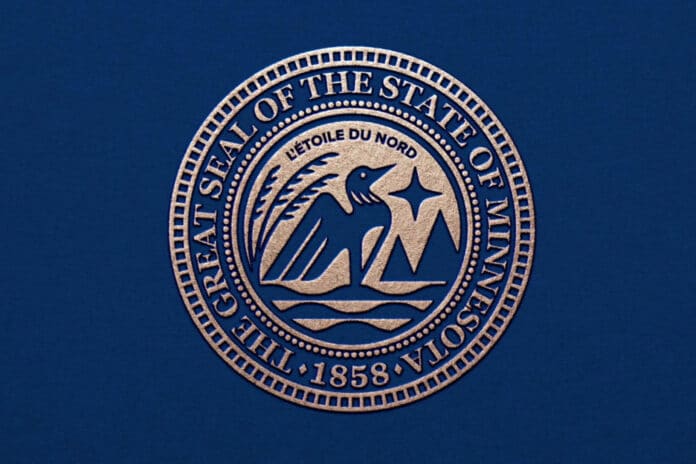A commission created by the DFL-controlled legislature earlier this year to redesign a new state seal and flag voted Tuesday to remove any mention of Minnesota’s statehood from the final rendering of the state seal. It also voted to remove the state motto “L’etoile du Nord” (which is French for “Star of the North”) among other changes before it officially voted to make the design final.
The commission also on Tuesday further narrowed a crop of finalists for a new state flag from six to three. It will meet again Friday with the goal of picking one winner, from what started as a pool of more than 2,000 submissions from the public this fall. It has, by statute, until Jan. 1, 2024 to submit to the legislature its chosen designs for a new state seal and flag. Those designs would then become official on May 11, 2024, which is “Statehood Day” in Minnesota.



The commission has been working on a new flag and seal design since September. It was formed via legislative declaration this summer after the DFL-controlled House and Senate passed an omnibus state government bill along party lines that included a controversial provision to ditch the state’s official flag and seal in favor of a new design.
Tense debate over language and whether statehood is ‘worth celebrating’
Just last week the 13-member commission chose a final state seal design from among hundreds of entries that features a scene where a loon appears to be taking flight from the surface of a body of water. Included in the background are what the designer, Ross Bruggink, explained are stalks of wild rice, a north star, and what appears to be coniferous forest in the distance.
On Tuesday the commission made four modifications to that design, including changing the eyes of the loon from yellow to red, removing the year “1858” and the state motto “L’etoile du Nord,” and adding the Dakota language phrase “Mni Sota Makoce” (pronounced “min-eh-so-tah me-coach-ay”), which translates to “Land where the waters reflect the sky.”
Those decisions were the subject of what turned into a tense debate among members of the State Emblems Redesign Commission about whether how some indigenous people who view the date as a “hurtful” reminder of the events surrounding Minnesota’s statehood is cause enough to remove “1858” from an official seal for the state.
“I don’t think anyone on this commission or in Minnesota would say that [1858] is a date or year not worth mentioning [on the seal],” said Secretary of State Steve Simon, a commission member. “It’s a year to celebrate our admission into the union.”
While Steve Simon was one of three commission members on Tuesday who advocated to keep the date on the seal, he was rebuffed by commission member Kate Beane, who told her colleagues the year 1858, which marks Minnesota’s entry in the union of states, “is not a date we are celebrating; it’s not something to honor.”
Why? Beane said the year 1858 reminds many people of Dakota heritage of a series of significant land cession treaties that ceded much of their tribal land to the territorial and (eventually) state government.
Last month, Beane, who was appointed to the commission as a representative of the Capitol Area Architectural and Planning Board (chaired by Lt. Gov. Peggy Flanagan), began publicly pushing other members of the commission to consider stripping the statehood date from a final design they submit to the legislature before the Jan. 1, 2024 deadline, because she said the year 1858 is “a hurtful, hurtful date, and a difficult time in history” for many members of tribal nations that reside inside the state’s borders.
“It’s a traumatic date for [Dakota people] to be looking at,” Beane said, who added that the charge of the commission is to look at “how to make these emblems more inclusive and representative of who we are as a state. Including the 1858 [on the seal] does the opposite of that.”
Simon, who sits on the commission as a representative of the Secretary of State’s Office (which is the official keeper of the state seal), said he appreciated Beane’s comments, but believed that those painful parts of history do not take away from the significance of Minnesota’s entry into the union, which he said is viewed by many today as a “joyous event,” similar to the way Americans celebrate Independence Day.
“My sense though is that Minnesotans can hold two thoughts in their head at once,” Simon said.
But Beane countered that Minnesota’s statehood is “not joyous. It’s a reality, it’s something we [as Dakota people] have learned how to navigate.”
Another member of the commission, Aaron Wittnebel, who was selected to serve on the commission by the Minnesota Indian Affairs Council’s Ojibwe community, said he favored keeping “1858” on the seal for more practical purposes.
“I think some people [on this commission] are getting a little too lost in the ceremonial role of the state seal,” Wittnebel said. “That’s not the purpose of the seal. The seal is to stamp official documents.”
Another commission member, Anita Gaul, who is a community college history instructor from Worthington, said she favored removing the date from the seal because “as a history teacher I know history is hard.”
“Why do we want a seal that causes pain to a significant number of people?” asked Gaul, a former DFL-endorsed candidate for state Senate who was appointed to the commission by Gov. Tim Walz. “There is a lot of pain in this world. We know what that date is; we don’t need it on the flag to remind us.”
The board then voted to officially remove the date from the seal, with Simon and Wittnebel the only two dissenting votes.
Legal challenges possible, Republican legislator says
Prior to its removal of the year “1858” from the seal, the commission debated whether it should include the state motto “L’etoile du Nord” on the seal, and if another language would be palatable to commissioner Beane who said the French phrase signifies a “colonial term that is not ours.” She advocated for replacing it with the Dakota phrase “Mni Sota Makoce,” which the commission eventually voted to approve in two separate actions.
Rep. Bjorn Olson, R-Fairmont, who sits on the commission with three other legislators as non-voting members, said that removing the state motto and replacing it with the Dakota phrase appears to deviate from the requirements of the statute instructing the commission that “symbols, emblems, or likenesses that represent only a single community or person, regardless of whether real or stylized, may not be included in a design.”
“Someone is going to look at this and say that should be there or shouldn’t be there,” Olson said. “And the secretary of state is going to have to defend that decision [in court].”
“Understand that when you make this vote, you will be saying do we or do we not want taxpayers dollars to be involved in defending this decision. I think in everyone’s heart of hearts [on this commission], they know this is controversial.”
Simon agreed with those sentiments.
“I would just ask members, since this is an item of some controversy, I would respectfully ask for a ‘no’ vote on this motion,” Simon said.
Four commission members voted against the motion to add the Dakota phrase in the place where the state motto once was included near the top of the seal.
Sen. Steve Drazkowski, R-Mazeppa, warned the commission that legislators are likely to debate the merits of the commission’s modifications to what he thought was initially a roundly supported final design.
“Before we came today, I thought this seal had a very good chance of sailing through the legislative session, and that people are really excited about this seal,” Drazkowski said. “Now we have removed the date of the state’s founding from it, we’ve removed the state motto … now we are almost going to make it the Dakota seal.”
“You have increased by ten or twentyfold the chances that [the seal design] would be changed in this next legislative session. Before today, I thought there would be a 0 percent chance of that.”
Hank Long
Hank Long is a journalism and communications professional whose writing career includes coverage of the Minnesota legislature, city and county governments and the commercial real estate industry. Hank received his undergraduate degree at the University of Minnesota, where he studied journalism, and his law degree at the University of St. Thomas. The Minnesota native lives in the Twin Cities with his wife and four children. His dream is to be around when the Vikings win the Super Bowl.












